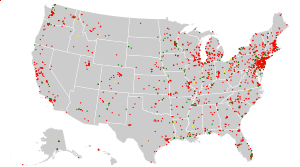National Priorities List

The National Priorities List (NPL) is the list of hazardous waste sites in the United States eligible for long-term remedial action (cleanup) financed under the federal Superfund program. Environmental Protection Agency (EPA) regulations outline a formal process for assessing hazardous waste sites and placing them on the NPL. The NPL is intended primarily to guide EPA in determining which sites warrant further investigation.
The inclusion of a facility in the National Priorities List does not reflect a judgment of its owner or operator or make the owner or operator take any action. It also does not assign any liability to any person or company. It serves as a source of information by identifying facilities or other hazardous substance releases that appear to warrant remedial actions.[1]
Process for listing waste sites
The Comprehensive Environmental Response, Compensation, and Liability Act of 1980 (CERCLA), also known as "Superfund", requires that the criteria provided by the Hazard Ranking System (HRS) be used to make a list of national priorities of the known releases or threatened releases of hazardous substances, pollutants, or contaminants in the United States.[2] This list is Appendix B of the National Contingency Plan, known as the "National Priorities List."
Hazardous waste sites become eligible for CERCLA/Superfund cleanup when EPA receives a report of a potentially hazardous waste site from an individual, state government, or responsible federal agency. EPA will first enter the potentially contaminated facility into a database known as the Comprehensive Environmental Response, Compensation, and Liability Information System (CERCLIS). Then, either EPA or the state in which the potentially contaminated facility is located will conduct a preliminary assessment, which decides if the facility poses a threat to human health and/or the environment. If the preliminary assessment shows the possibility of contamination, EPA (or the state under agreement with EPA) will conduct a more detailed site inspection. EPA then uses the HRS to review any available data on the site to determine whether its environmental or health risks are enough to qualify the facility for a Superfund cleanup. Generally, facilities with overall scores of 28.50 and greater on the Hazardous Ranking System are eligible for the National Priorities List.[3]
Another way facilities can be included in the National Priorities List is if a state or territory designates one top-priority site within its jurisdiction, regardless of the site's HRS score. The last way a site can be included in the NPL is if it meets the following three requirements:
- The Agency for Toxic Substances and Disease Registry has issued a health advisory that recommends removing people from the facility.
- EPA determines that the site poses a significant threat to public health.
- EPA believes that it will be more cost-effective to use its remedial authority (which is only available at National Priorities List facilities) than to use its emergency removal authority in responding to the facility.[3]
EPA may delete a final NPL site if it determines that no further response is required to protect human health or the environment. Also, sites where a remediation was completed through the Superfund program are typically deleted from the list. As of July 31, 2010, there are 1,277 sites listed on the NPL. Since its inception in 1980, an additional 343 have been delisted, and 61 new sites were proposed as of 2010.[4]
Public comment process
The public has the opportunity to comment on facilities that are proposed to be added to the National Priorities List. EPA publishes notices in the Federal Register listing the proposed facilities. The agency will consider all comments received within 60 days after publication in the Register. The complete set of comments are available to the public one week following the close of the comment period. EPA makes a final listing of decisions after considering all the relevant comments that were received during the comment period.[5]
EPA Superfund docket
The Superfund docket contains the Hazardous Ranking System score sheets for each proposed facility, a documentation record for each facility that details the information used to compute the score, information for any facility affected by particular statutory requirements or EPA listing policies, and a list of documents referenced in the documentation record.[5]
Mapping System
TOXMAP is a geographic information system (GIS) from the Division of Specialized Information Services of the United States National Library of Medicine (NLM) that uses maps of the United States to help users visually explore data from the EPA Superfund Basic Research Program and the Toxics Release Inventory. TOXMAP's chemical and environmental health information is taken from NLM's Toxicology Data Network (TOXNET),[6] PubMed, and from other authoritative sources.
References
- ↑ "National Priorities List." The Encyclopedia of Earth. (Washington, DC: National Council for Science and the Environment.) Accessed 2010-04-25.
- ↑ United States. Comprehensive Environmental Response, Compensation, and Liability Act of 1980. Sec. 105(a)(8)(B); 42 U.S.C. § 9605
- 1 2 "National Priorities List". Scorecard: The Pollution Information Site. Retrieved 2010-04-25.
- ↑ U.S. Environmental Protection Agency (EPA). Washington, DC. "National Priority List Site Totals by Status and Milestone." As of 2010-07-30.
- 1 2 EPA. "National Priorities List: Public Comment Process." 2010-05-10.
- ↑ U.S. National Library of Medicine. TOXNET
External links
- National Priorities List - EPA
- Search for Superfund Sites Where You Live - EPA
- TOXMAP: Environmental Health e-map - National Library of Medicine